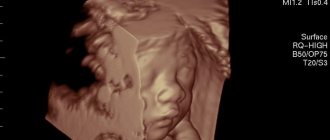Body changes and new sensations for women
Of course, a woman at 35 weeks of pregnancy cannot be called graceful. A huge belly makes the expectant mother clumsy; the uterus, which has increased several times in size, with a baby that is quite heavy at this stage, puts pressure on the diaphragm (it is difficult for a woman to breathe), on the stomach (heartburn occurs), on the bladder (a pregnant woman goes to the toilet even more often). All this, of course, is unpleasant, but very soon (in just one or two weeks) the bottom of the uterus will begin to descend - the baby needs to prepare for passage through the birth canal. From now on you will feel much lighter. Well, your previous shape will return to you after childbirth, although, alas, you won’t be able to lose weight quickly right away.
Good to know
Childbirth with a scar on the uterus
What awaits a premature baby immediately after birth in the hospital?
How to choose a nursing bra
Is a pregnant woman beautiful?
What worries a woman during pregnancy?
What are the methods of preparing for childbirth?
All texts for pages about mother and baby were kindly provided by RAMA Publishing - these are chapters from the book by Svetlana Klaas “Your Favorite Little Man from Conception to Birth”, reviewer Irina Nikolaevna Kononova, Candidate of Medical Sciences, Associate Professor of the Department of Obstetrics and Gynecology of the Ural State Medical Academy (Ekaterinburg).
Nutrition at 35 weeks of pregnancy
You've already switched to 5 meals a day, right? If not, be sure to do it at 35 weeks of pregnancy. To avoid overloading your stomach, eat food approximately every 3-3.5 hours. Reduce the amount of meat in your diet - this will help avoid ruptures during childbirth. Are you afraid of swelling? Limit your fluid intake (drinks and soups) to one liter per day, as well as salt. Increase your consumption of vegetables and fruits, vegetable oil (it will make the tissues of the birth canal more elastic).
Useful advice for future parents
The image of the Kid is rarely clear.
And if it does happen, it is most often tied to the moment of his birth. And there is a simple explanation for this: the image must be holistic, and until the moment of birth the Baby is constantly changing, and it is simply impossible to imagine what he is like at the moment. Ultrasound helps this a little, although the resulting pictures are more likely a positive fact of the child’s existence for you than a portrait that you want to hang on the wall. And yet, you will need to work on the image of the Baby: the more distinct it turns out, the warmer and more active your relationship with the baby will be even before birth. The image of the Kid consists of several components:
- visual image. Someone in their imagination makes the Baby look like toddlers from magazine pages, or familiar children, or older children (if there are any in the family), or even like the parents themselves in infancy. And some people develop an image that is independent of anything. There are also those (and perhaps most of them) who do not have a visual image at all. Be that as it may, the visual image is far from the main component of your Baby’s image;
- emotional image. It is connected with the feelings that you have for your baby. Your love, tenderness, optimism will allow you to imagine a joyful, active, sunny Baby. Mothers experiencing a decline in mood and physical activity begin to develop images of capricious, sad, empathizing Kids. The emotional image of your Baby is one of the most powerful;
- tactile image. It manifests itself in ideas about physical contact with the Baby: how you will feed him, rock him, stroke his head, tummy, back, bend and straighten his arms and legs, etc. Many mothers, without realizing it, actively contribute to the formation of a tactile image: they fuss with babies, sleep cuddled with toys, and if there are cats or dogs in the house, then they will have to try themselves in the role of a Baby who is cuddled and raised. In conjunction with the emotional image, the tactile image creates an almost tangible idea of the Baby.
Information about what he is like in each specific period before birth, information from the leading doctor about the size of his body, how his heart beats, how he has grown over the week (month) and what position he occupies in your tummy helps to create the image of the Baby.
The image of the Baby is closely related to your activities and self-development. So, if you are active, generally satisfied with life, you have many plans for life, and have favorite hobbies, then you will see your Baby as well-rounded, cheerful and talented.
A significant role in shaping the image of the Kid belongs to his dad. Very often, even before birth, fathers boldly create specific images: “When he grows up, we’ll ride bikes with him,” “My daughter won’t be afraid of anything,” “I’ll walk with my son, even in the rain, even in the snow, let him harden himself,” “ Finally, I will have a real rival in computer games,” “When a girl is born, we will grow our braids down to our toes.”
Whatever the image of your Baby, it is needed so that you feel him physically and mentally, strive to communicate with him, feel proud of his success in growth and development, and also love him very much.
Belly shape
There is a myth that the gender of the child can be determined by the shape of the expectant mother’s belly: if the belly is wider and rounder, it means there will be a girl; if the stomach is narrower, but protrudes forward more, it’s a boy.
It is impossible to determine the gender of a child by the shape of the belly.
However, this is not so: the shape of the abdomen depends on the individual characteristics of the woman and on the presentation of the fetus. The most reliable way to find out the sex of the baby is an ultrasound.
The shape of the abdomen depends on the individual characteristics of the mother and the presentation of the fetus
Medical observation
In some cases, at 35 weeks of pregnancy, the gynecologist may prescribe an ultrasound. The study will allow you to determine the weight and position of the child, as well as identify possible complications, for example, anomalies of the placenta, oligohydramnios or polyhydramnios, entanglement of the fetus with the umbilical cord, etc. The information obtained will help the specialist develop tactics for future childbirth.
This week the doctor will definitely measure your blood pressure and determine your weight and size. In addition, as usual, you will need to do a general urine and blood test.
Deadly pregnancy complication: who is at risk
Monitoring the course of pregnancy is 50% highly artistic pasting tests into a card, and 50% - performing completely routine procedures: weighing, measuring the abdomen with a centimeter tape, examining the limbs and measuring blood pressure (BP). On two hands. Necessarily. From an early date.
Once upon a time, the USSR managed to significantly reduce maternal mortality rates in a simple but surprisingly effective way.
A midwife was stationed in every small settlement who could measure a pregnant woman’s blood pressure and independently boil a portion of urine in order to find protein in it.
Simple midwives in the USSR and highly educated obstetrician-gynecologists in modern Russia are doing the same thing - persistently looking for signs of impending preeclampsia - a formidable and deadly complication of pregnancy.
What is preeclampsia?
This is a serious complication of pregnancy, in which the functioning of the entire body is seriously disrupted. In addition to the increase in blood pressure, a large amount of protein appears in the urine, the number of platelets in the blood decreases, the functioning of the liver and kidneys suffers, epigastric pain, visual disturbances, and severe headaches appear.
The condition can rapidly progress and lead to convulsions with loss of consciousness - eclampsia.
Preeclampsia begins after 20 weeks of pregnancy. The sooner, the more dangerous. Preeclampsia that develops before 32 weeks of pregnancy is considered early; pregnancy always ends prematurely, because attempts to preserve it can kill both mother and child.
Sometimes preeclampsia develops in the postpartum period, which is why obstetrician-gynecologists never relax.
Why is this happening?
Science still cannot give an exact answer to this question, despite the fact that the pathogenesis of the disease is well studied.
In some cases we can predict the development of the disease, but almost never we can prevent it.
At risk:
- primigravida;
- women who had preeclampsia in a previous pregnancy;
- preeclampsia in relatives (mother, sister);
- women who suffered from arterial hypertension before pregnancy or experienced an increase in blood pressure for the first time before 20 weeks;
- women with a history of kidney disease;
- women with diabetes mellitus, autoimmune diseases (systemic lupus erythematosus, scleroderma, antiphospholipid syndrome), thrombophilic conditions;
- obese women;
- women aged 40+ (another hello to all fans of the idea of delayed motherhood);
- multiple pregnancies;
- pregnancy after IVF
What is the child's risk?
Preeclampsia may require emergency delivery at any stage of pregnancy. This is often the only way to save the mother's life.
Severe prematurity in a newborn is a heavy burden that can affect the rest of a person’s life. Despite the breakthrough successes of modern neonatology, which has made it possible to nurse 500-gram babies, the mortality rate among premature babies is very high.
What does a woman risk?
Women who experience preeclampsia are likely to experience the condition in each of their pregnancies, with subsequent preeclampsia always more severe than the previous one.
Despite the fact that preeclampsia goes away with pregnancy, the risks of developing cardiovascular diseases, hypertension, stroke and heart attack remain.
Without adequate help, you may develop eclampsia, a severe seizure disorder similar to epilepsy. Acute renal failure, pulmonary edema are rapidly increasing, stroke or myocardial infarction, placental abruption, sudden intrauterine fetal death, retinal detachment with loss of vision can occur.
What is HELLP syndrome?
HELLP syndrome was first described in 1954. This is an abbreviation made up of the first letters: hemolysis - intravascular destruction of red blood cells (Hemolysis), increased activity of liver enzymes (Elevated Liver enzymes) and thrombocytopenia (Low Platelet Count).
This serious and potentially fatal condition is accompanied by severe blood clotting disorders, necrosis and rupture of the liver, and cerebral hemorrhages.
Dangerous symptoms
You should immediately consult a doctor if swelling appears on the face and hands, headaches that do not go away after taking conventional medications, blurred vision - blurred vision, “veil and fog”, flashing “spots” before the eyes.
Preeclampsia can manifest itself as pain in the epigastric region, right hypochondrium; nausea and vomiting in the second half of pregnancy, difficulty breathing are dangerous. A sudden weight gain (3-5 kg per week) may be a warning sign.
Preeclampsia is not mild
The most difficult thing for an obstetrician-gynecologist is not to panic ahead of time. Sometimes the situation allows you to delay time a little to allow the fetal lungs to ripen.
Up to 34 weeks, corticosteroids are administered to prevent respiratory distress syndrome. Sometimes the situation quickly worsens and requires immediate action and delivery.
How to prevent preeclampsia?
Unfortunately, doctors can predict many obstetric complications, but cannot prevent them. Over the years of research, a long list of disappointments has accumulated. The bed-rest regimen (resting in a lying position during the day), limiting table salt, fish oil or taking garlic tablets will definitely not help prevent the development of preeclampsia.
Neither taking progesterone medications, nor using magnesium sulfate, nor taking folic acid, nor using heparins, including low molecular weight ones (Clexane, Fraxiparin) is not a preventive measure. However, all of these drugs can be used during pregnancy for other purposes.
If the risk of preeclampsia is high, your doctor may suggest taking acetylsalicylic acid daily after the 12th week of pregnancy.
Pregnant women with low calcium intake (<600 mg per day) are advised to take supplemental calcium in the form of medications.
The best thing you can do is take care of prevention before pregnancy. Hypertension should be well controlled before conception.
Obesity requires weight loss, diabetes requires compensation and reliable control. Unfortunately, this is the right but difficult path.
Most often, women come into pregnancy with a whole bunch of problems that require urgent solutions.
Obstetricians and gynecologists around the world continue to measure blood pressure. On two hands. On every visit. And they ask you not to forget to regularly take a general urine test. This is a life-saving strategy.
Oksana Bogdashevskaya
Photo depositphotos.com
The opinion of the author may not coincide with the opinion of the editors









